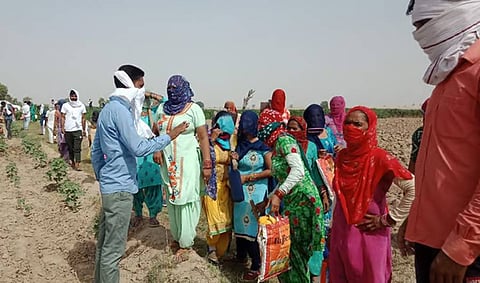

While urban migration is soaring across the country, there are two villages in Rajasthan where the residents wish to stay in their rural environment. They do not wish their villages to be deemed as an urban area in official terms.
Their desire stems from the bureaucratic outcome of marking their villages as urban population centres.
The residents of Goluwala Sihagaan and Goluwala Nivadaan villages in Hanumangarh district want to continue benefiting from the Mahatma Gandhi National Rural Employment Guarantee Act (MGNREGA) and various rural development and social security schemes.
Consequently, they have also rejected the idea of merging the two villages into a single urban municipality.
Goluwala Nivadaan and Goluwala Sihagaan are located within the Peelibanga Panchayat Samiti area. These neighbouring residents maintain that until about 20 years ago, the two villages appeared distinct, but due to population growth, they have become interconnected, diminishing their boundaries.
Last year, the Rajasthan government had dissolved the Panchayat councils of both villages and formed a municipality instead, stating that the decision would set in motion a series of urban-themed development initiatives.
Initially, the rationale didn’t seem problematic for the residents. But shortly after the municipality began functioning, and the work under MGNREGA was halted, the residents became agitated.
Protest marches against the municipality started from the villages and continued till the district headquarters.
Jagdish Saraswat, a resident of Goluwala Sihagaan and a member of the Communist Party of India (Marxist)’s tehsil committee, told Down To Earth (DTE), “MGNREGA is a significant source of livelihood for the villagers. When it was stopped, it was natural for the workers to be upset. After several days without a response from the government, the villagers filed a petition in the Rajasthan High Court. The court issued a stay order on July 25, 2023, leading the municipality to cease operations and allowing both village councils to resume their work.”
This case is still pending with the Rajasthan High Court, with hearings occurring periodically and the stay order regarding the formation of the municipality remains in effect, ensuring there are no disruptions in the functioning of the village councils.
However, any hint of disturbance makes the villagers uneasy.
Villager Balvinder Kharoliya told DTE, “Three to four months ago, the state government issued orders for the appointment of an executive officer in the Goluwala Municipality. This incited anger among MGNREGA workers. However, once it became clear that this order had been issued due to an oversight by local body officials, the workers breathed a sigh of relief.”
Meanwhile, the Communist Party functionary noted, “There are about 3,000 cards in both the councils, with approximately 6,000 names registered. Half of these are active workers who go for MGNREGA jobs. Their livelihoods depend on the payments they receive from MGNREGA. Workers who manage to work for a hundred days a year also benefit from various schemes of the Labour Welfare Board.”
The Pradhan Mantri Gramin Aawas Yojana, a rural housing scheme, is also a significant support for the rural residents, enabling them to build concrete homes.
“The village residents also receive benefits from other social security and welfare schemes. If the municipality is established, all of this will stop. Goluwala Sihagaan has 13 wards and Sihagaan has 19, of which only two are well-off,” he added.
While people from all castes work under MGNREGA, the majority of these workers belong to the Scheduled Castes and Other Backward Classes.
Chavli Nayak, 60-year-old MGNREGA worker told DTE, “Because of the council, we get work under MGNREGA. My husband, son, and I go for MGNREGA work. If the municipality is formed, what will we do since we don’t even have agricultural land?”
Similarly, 45-year-old MGNREGA worker Jamna Nayak said, “I go to work under MGNREGA. My husband works elsewhere. Together, we are educating our two children. MGNREGA should continue; we have no interest in the municipality.”
Sixty-five-year-old Saraswati Meghwal is a widow. Her two married sons support the family through daily wage labour. Her daughter is also married.
“I work under MGNREGA. It brings money into my hands. I don’t have to beg from anyone when I need something. Last year, when MGNREGA was halted, it created difficulties for me. We don’t need a municipality in the village; we need MGNREGA. It should continue,” Meghwal told DTE.
Rampal Nayak, another MGNREGA worker, stated that the closure of MGNREGA would be a significant loss for the poor.
“With the declaration of urban status, various taxes would be imposed,” MGNREGA worker Subhash Meghwal said.
“My father, mother, and I work under MGNREGA. Our household supplies come through MGNREGA. Shopkeepers even extend credit to us because they know we will repay as soon as we receive our payment from MGNREGA,” he added.
Interestingly, the local shopkeepers and traders support the formation of the municipality.
Rakesh Dhaka, president of the Hanumangarh Traders’ Association, told DTE, “The roads here are broken and there are no drainage facilities. If a municipality is formed, a larger budget will be available. This will not only pave the way for development but also solve many problems.”
Goluwala Nivadaan’s village development officer, Sushil Kumar Siddh, said that after the High Court’s stay order, the village council resumed its work. Employment is being provided to workers under MGNREGA, and eligible villagers are benefiting from other schemes as well.
The opinions of the traders and shopkeepers find resonance with Bindu Saraswat, the sarpanch [Gram Panchayat head] of Goluwala Sihagaan who mentioned that village councils have limited resources.
“From a development perspective, a municipality may be better, but the concerns of MGNREGA workers are valid. MGNREGA would cease if a municipality is formed. Although there is the Indira Gandhi Urban Employment Scheme, it will not provide as much work as MGNREGA. They would also lose the benefits of the PM Rural Housing Scheme,” he told DTE.